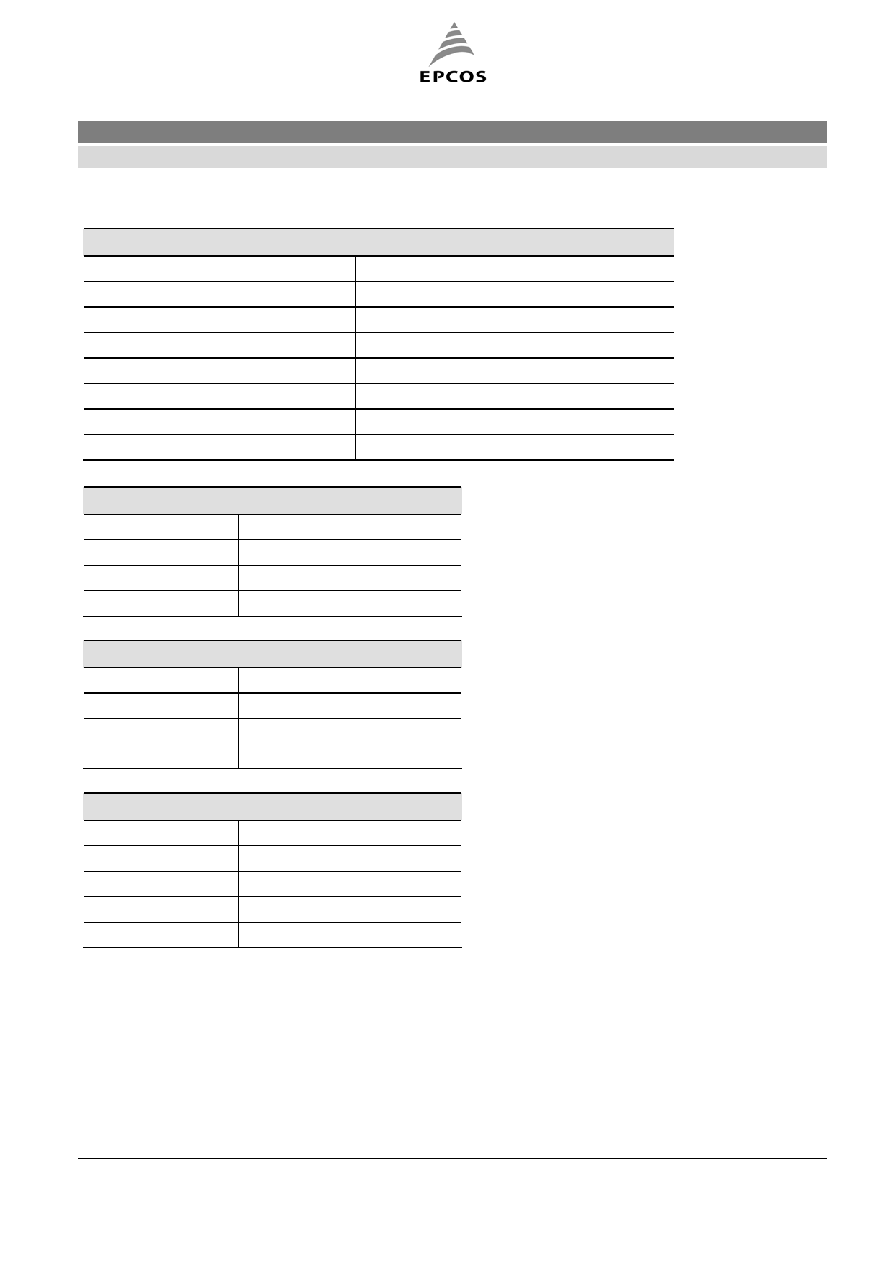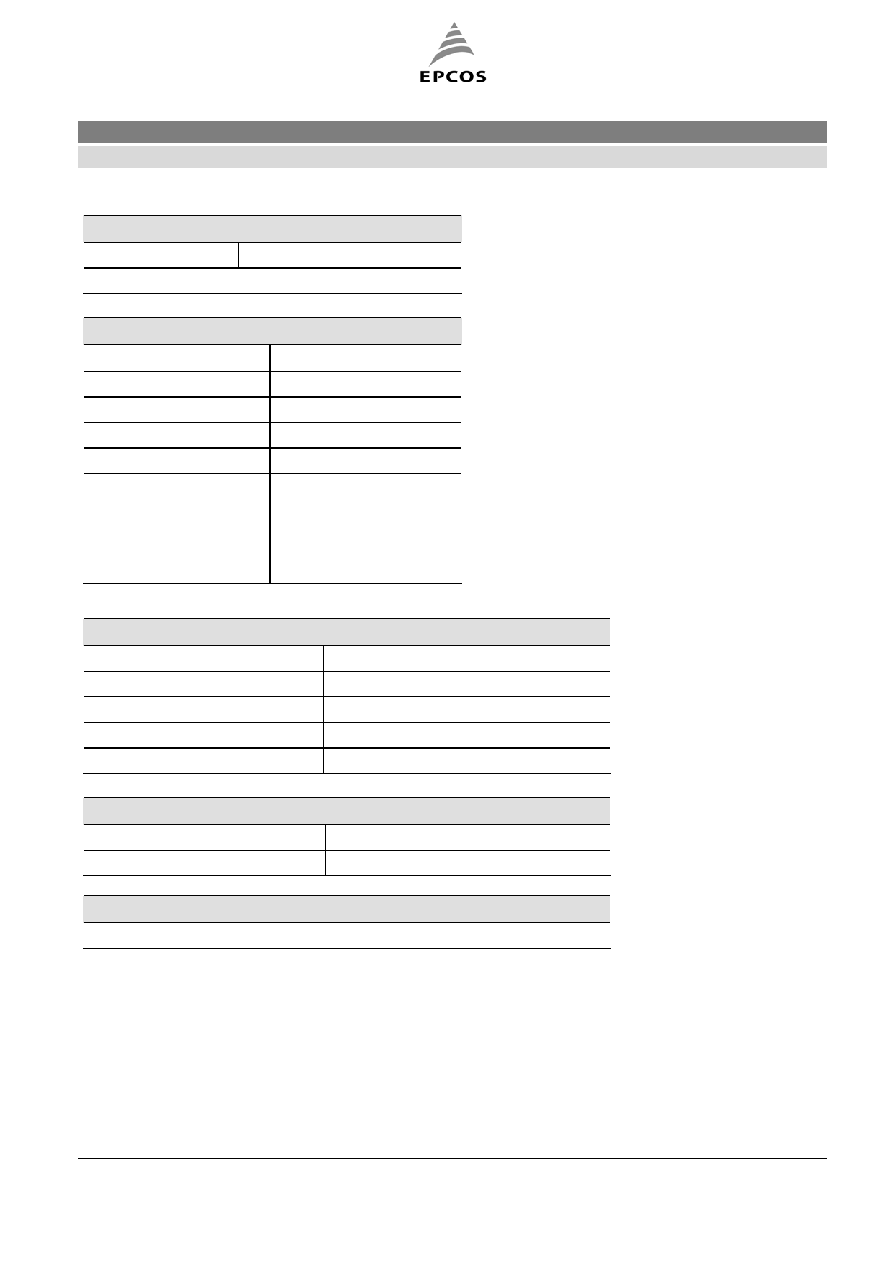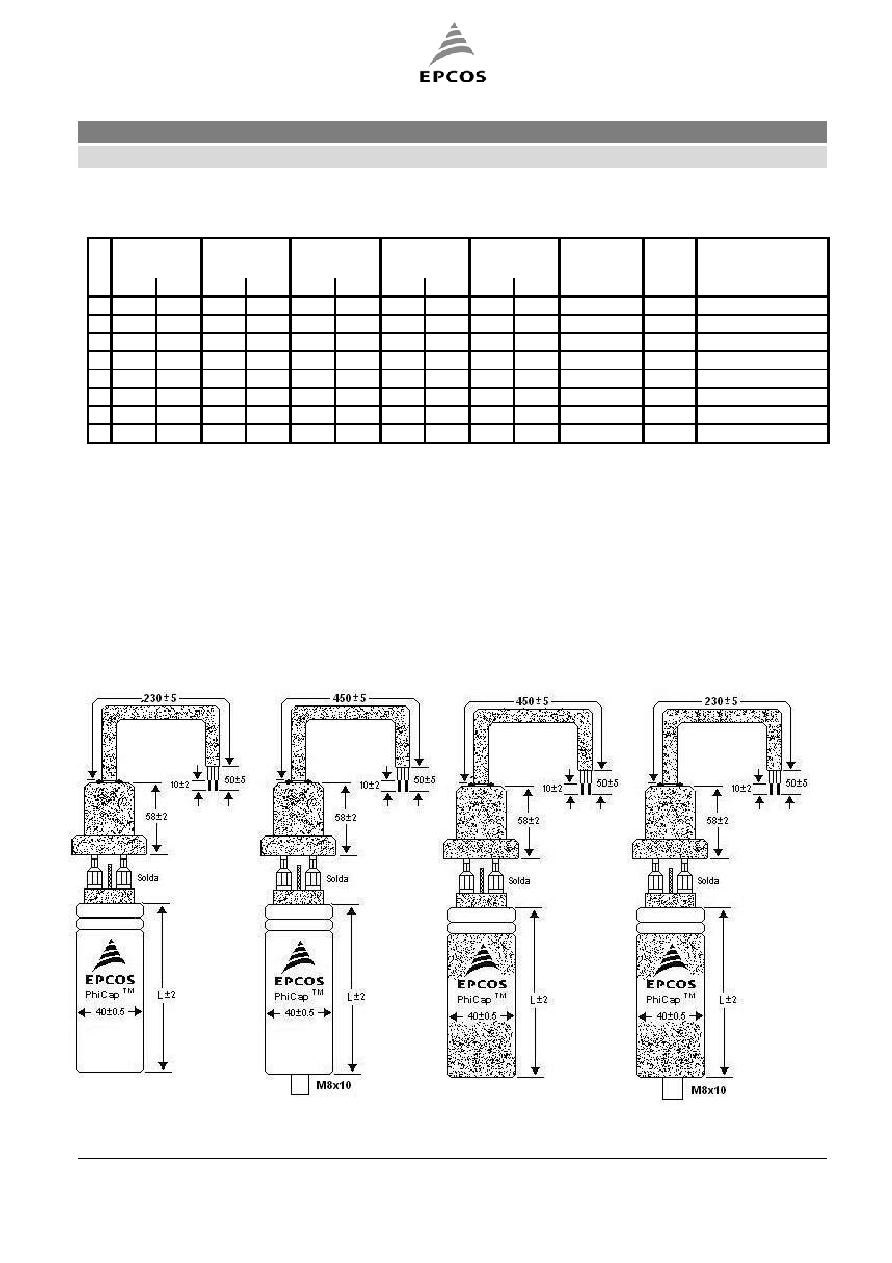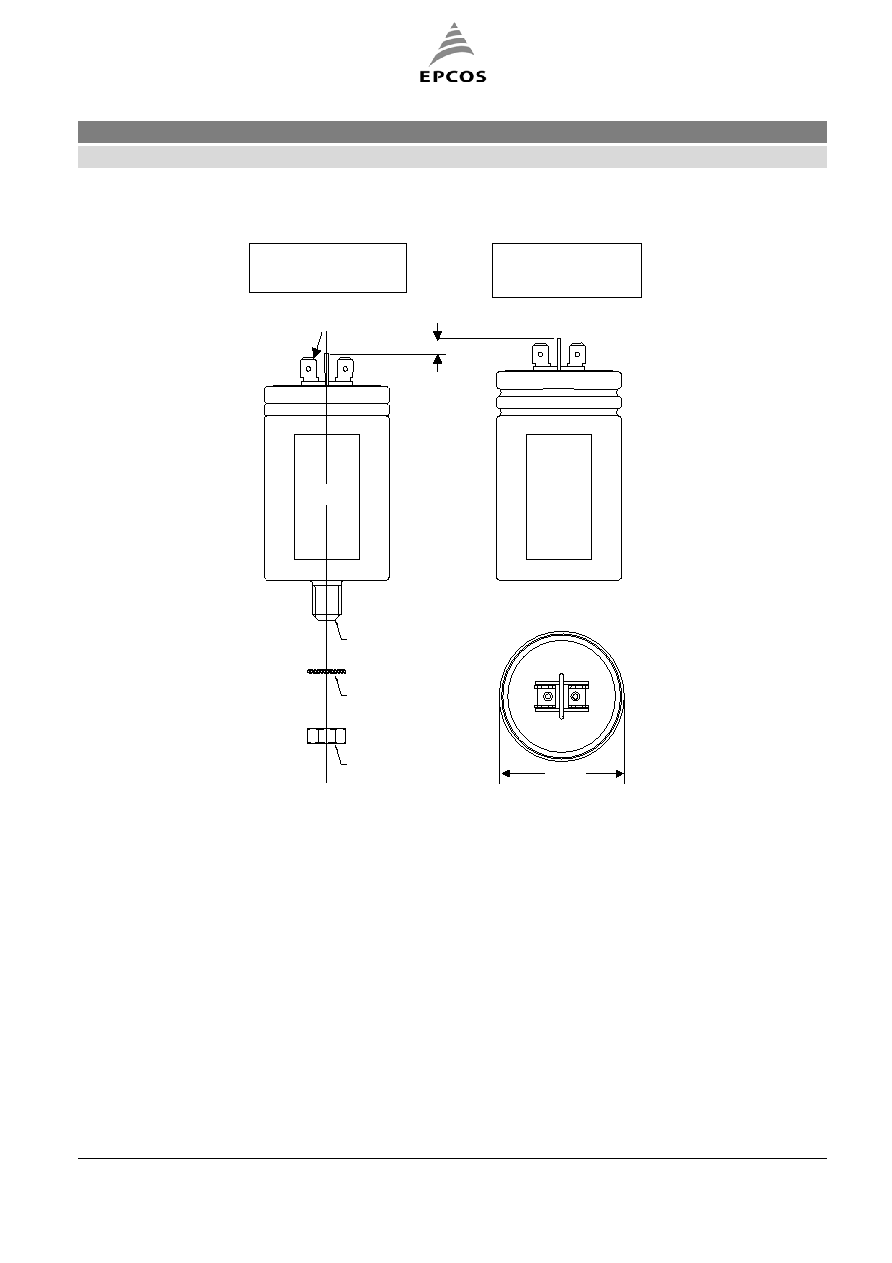
HomeCap capacitors for Power Factor Correction
MKP
Series/Type: HomeCap
Ordering code: B32340C....Jxxx
Date: September
2005
Version: 3
Content of inside pages of data sheet. Data will be automatically entered into frontpage
headlines, headers and footers. Please fill in the table and then change the colour to "White".
This ensures that the table disappears for the customer PDF.
Identification/Classification 1:
(header 1)
HomeCap capacitors for Power Factor Correction
Identification/Classification 2:
(header 2)
MKP series
Ordering code:
B32340C....Jxxx
Series/Type:
Preliminary data (optional):
(if necessary)
Department:
FK PFC R&D
Date: September
2005
� EPCOS AG 2005. Reproduction, publication and dissemination of this data sheet, enclosures hereto and the information
contained therein without EPCOS' prior express consent is prohibited.

HomeCap capacitors for Power Factor Correction
B32340C....Jxxx
MKP series
1
h
2
3
Construction
Dielectric: Polypropylene film
Internally insulated, no grounding required
Soft polyurethane resin, non PCB (NPCB)
Aluminium can
Features
Self-healing properties
Low dissipation factor
Overpressure disconnection device
High insulation resistance
Typical applications
Residential power factor correction unit
Product composition
Cable (
1
)
Plastic terminal protection cover (
2
)
Capacitor
file 106388 (
3
)
Cable
Cross section: 1.5 mm
2
(14AWG)
Length:
300
mm
Rated voltage: 600Vac
Operation temperature: 105�C
Material: Electrolytic copper with PVC Insulation
Dimensions
D1: 42.5 � 1 mm
h: see product table.
L1: 10 � 1 mm
L2: 58 � 1 mm
L3: 50 � 5 mm
L4: 10 � 2 mm
FK PFC R&D
September 2005
Please read the
Cautions and warnings
and
Page 2 of 10
the
Important notes
at the end of this document

HomeCap capacitors for Power Factor Correction
B32340C....Jxxx
MKP series
Technical data and specifications
Characteristics
Rated capacitance C
R
According to dimension table, 5 to 33 �F
Tolerance
-5 / +10%
Connection cables
Rated voltage V
R
400 V (Application voltage 127 ... 400 V)
Rated frequency
f
R
50 Hz / 60 Hz
Output 50/60 Hz
According to dimension table 0.25 ...1.66 kvar
Rated current I
R
According with the power rating
tan (dielectric)
0.5 w/kvar
Maximum ratings
V
max
(up to 8 h daily) 1.1 x V
R
V
max
(up to 1 min)
1.3 x V
R
I
max
1.3 x I
R
(A)
I
S
100 x I
R
(A)
Test data
V
TT
2.15 x V
R
, 60 s (type test)
V
TC
3 000 VAC, 60 s (type test)
tan (120 Hz)
at 20 �C
1.0 x 10
-3
Climatic category / -25/D
T
min
(-)
25 �C
T
max
(+)
55 �C
Damp heat test t
test
21 days
Humidity
av. rel. < 65%
Maximum altitude
4 000 m
FK PFC R&D
September 2005
Please read the
Cautions and warnings
and
Page 3 of 10
the
Important notes
at the end of this document

HomeCap capacitors for Power Factor Correction
B32340C....Jxxx
MKP series
Mean life expectancy
t
LD
Up to 100,000 hours
Max. 5 000 switching per year acc. to IEC 60831
Design data
Dimensions (
x l)
According dimension table
Weight approx
According dimension table
Impregnation
Soft polyurethane resin
Fixing
Al can stud or bracket
Max. torque (Al can stud) 4 Nm
Mounting position
Any mounting position
possible. See
"Maintenance and
Installation Manual" for
further details.
Terminals
Enclosure IP53,
indoor
mounting
Cable cross section
1.5 mm
2
(14 AWG)
Maximum terminal current
15 A
Creepage distance
12.7 mm minimum
Clearance
9.5 mm minimum
Safety
Mechanical safety
Overpressure disconnector
Max. short circuit current
10 KA
Reference standards
IEC 60831-1/2 and UL 810
Discharge resistors are available upon request. Discharge resistor time according IEC specification for specific
types .
FK PFC R&D
September 2005
Please read the
Cautions and warnings
and
Page 4 of 10
the
Important notes
at the end of this document

HomeCap capacitors for Power Factor Correction
B32340C....Jxxx
MKP series
Product table
C
R
Dimensions Weight
Ordering Code*)
d x h
�F 50 Hz 60 Hz 50 Hz 60 Hz 50 Hz 60 Hz 50 Hz 60 Hz 50 Hz 60 Hz
(mm)
(kg)
5
0.25
0.30
0.09
0.11
0.08
0.10
0.08
0.09 0.025 0.030
40 x 70
0
.15 B32340C4056J00
0
7
0.35
0.42
0.13
0.15
0.12
0.14
0.11
0.13
0.04
0.04
40 x 70
0
.15 B32340C4076J00
0
10 0.50
0.60
0.18
0.22
0.17
0.20
0.15
0.18
0.05
0.06
40 x 70
0
.15 B32340C4106J00
0
15 0.75
0.90
0.27
0.33
0.25
0.30
0.23
0.27
0.08
0.09
40 x 80
0
.16 B32340C4156J00
0
20 1.00
1.21
0.36
0.43
0.33
0.40
0.30
0.36
0.10
0.12
40 x 105
0
.18 B32340C4206J00
0
25 1.25
1.51
0.45
0.54
0.42
0.50
0.38
0.46
0.13
0.15
40 x 105
0
.18 B32340C4256J00
0
30 1.50
1.81
0.54
0.65
0.50
0.60
0.46
0.55
0.15
0.18
40 x 125
0
.20 B32340C4306J00
0
33 1.66
1.99
0.60
0.72
0.55
0.66
0.50
0.60
0.17
0.20
40 x 125
0
.20 B32340C4336J00
0
127 Vac
(
kvar)
(
kvar) (kvar) (kvar) (kvar)
400 Vac
240 Vac
230 Vac
220 Vac
*)Types of products range by code identity.
Without studs in the aluminum can, cable length 300 mm: Jxx
0
.
Without studs in the aluminum can, aluminum can with PVC cover 180 um thickness, cable length 300 mm: Jxx
1
.
Without studs in the aluminum can, cable length 500 mm: Jxx
2
.
Without studs in the aluminum can, aluminum can with PVC cover 180 um thickness, cable length 500 mm: Jxx
3
.
With studs in the aluminum can, cable length 300 mm: Jxx
4
.
With studs in the aluminum can, aluminum can with PVC cover 180 um thickness, cable length 300 mm: Jxx
5
.
With studs in the aluminum can, cable length 500 mm: Jxx
6
.
With studs in the aluminum can, aluminum can with PVC cover 180 um thickness, cable length 500 mm: Jxx
7
.
FK PFC R&D
September 2005
Please read the
Cautions and warnings
and
Page 5 of 10
the
Important notes
at the end of this document

HomeCap capacitors for Power Factor Correction
B32340C....Jxxx
MKP series
Visual fault indicator
Before safety
device operation
After safety
device operation
DIN934
DIN6797-A
M12
Terminal 6,35mm
13mm Max
�D�1,0
MARKING
MARKING
FK PFC R&D
September 2005
Please read the
Cautions and warnings
and
Page 6 of 10
the
Important notes
at the end of this document

HomeCap capacitors for Power Factor Correction
B32340C....Jxxx
MKP series
Cautions and warnings
In case of dents of more than 2 mm depth or any other mechanical damage, capacitors must not
be used at all.
To ensure the full functionality of the overpressure disconnector, elastic elements must not be
hindered and a minimum space of 5 cm has to be kept above each capacitor.
Do not handle the capacitor before it is discharged to max. 10% of rated voltage.
Resonance cases must be avoided by appropriate application design in any case.
Handle capacitors carefully, because they may still be charged even after disconnection due to
faulty discharging devices.
Protect the capacitor properly against over current and short circuit.
Failure to follow cautions may result, worst case, in premature failures, bursting and fire.
Discharging
Capacitors must be discharged to a maximum of 10% of rated voltage before they are switched in
again. This prevents an electric impulse discharge in the application, influences the capacitor's
service life and protects against electric shock. The capacitor must be discharged to 75 V or less
within 3 minutes. There must be not any switch, fuse or any other disconnecting device in the circuit
between the power capacitor and the discharging device. PoleCap capacitors have a pre-mounted
ceramic discharge module; alternatively discharge reactors are available from EPCOS. Discharge and
short circuit capacitor before handling!
Service life expectancy
Electrical components do not have an unlimited service life expectancy; this applies to self-healing
capacitors too. The maximum service life expectancy may vary depending on the application the
capacitor is used in.
Safety
Ensure good, effective grounding for capacitor enclosures.
Provide means of disconnecting and insulating a faulty component/bank.
Handle capacitors carefully, because they may still be charged even after disconnection due to
faulty discharging devices.
The terminals of capacitors, connected bus bars and cables as well as other devices may also be
energized.
Follow good engineering practice.
Overcurrent and short circuit protection
Use HRC fuses or MCCBs for short circuit protection. Short circuit protection and connecting
cables should be selected so that 1.5 times the rated capacitor current can be permanently
handled.
HRC fuses do not protect a capacitor against overload
- they are only for short circuit protection.
The HRC fuse rating should be 1.6 to 1.8 times rated capacitor current.
Do not use HRC fuses to switch capacitors (risk of arcing).
Use thermal magnetic overcurrent relays for overload protection.
FK PFC R&D
September 2005
Please read the
Cautions and warnings
and
Page 7 of 10
the
Important notes
at the end of this document

HomeCap capacitors for Power Factor Correction
B32340C....Jxxx
MKP series
Resonance cases
Resonance cases must be avoided by appropriate application design in any case. Maximum total
RMS capacitor current (incl. fundamental harmonic current) specified in technical data must not be
exceeded.
Overtemperature
Exceeding maximum allowed temperature may set the safety device out of operation.
Overpressure disconnector
To ensure full functionality of an overpressure disconnector, the following must be observed:
1. The elastic elements must not be hindered, i.e.
- connecting lines must be flexible leads (cables),
- there must be sufficient space (min. 5 cm) for expansion above the connections (see
"Clearing distance for overpressure disconnector").
- folding beads must not be retained by clamps.
2. Maximum allowed fault current of 10000 A in accordance with UL 810 standard must be assured by
the application.
3. Stress parameters of the capacitor must be within the IEC60831 specification.
Re-switching vs. phase-opposition
In case of voltage interruption, a sufficient discharge time has to be ensured to avoid phase-
opposition and resulting high inrush currents
.
Vibration resistance
The resistance to vibration of capacitors corresponds to IEC 68, part 2�6.
Max. test conditions:
Test duration
2 h
Frequency range 1
0 ... 55 Hz corresponding
to max. 0.7 g
Displacement amplitude
0.75 mm
These figures apply to the capacitor alone. Because the fixing and the terminals may influence the
vibration properties, it is necessary to check stability when a capacitor is built in and exposed to
vibration. Irrespective of this, you are advised not to locate capacitors where vibration amplitude
reaches the maximum in strongly vibrating equipment.
Mechanical protection
The capacitor has to be installed in a way that mechanical damages and dents in the aluminium can
are avoided.
FK PFC R&D
September 2005
Please read the
Cautions and warnings
and
Page 8 of 10
the
Important notes
at the end of this document

HomeCap capacitors for Power Factor Correction
B32340C....Jxxx
MKP series
Clearing distance for overpressure disconnector
Above each capacitor, a minimum space of 5 cm has to be kept. This will allow the visual control to
work and enable a longitudinal extension of the can to secure the over-pressure disconnector work.
Grounding
The threaded bottom stud of the capacitor has to be used for grounding. In case grounding is done
via metal chassis that the capacitor is mounted to, the layer of varnish beneath the washer and the
nut should be removed. The maximum tightening torque is 4 Nm.
Maintenance
Check tightness of the connections/terminals periodically.
Take current reading twice a year and compare with nominal current. Use a harmonic analyser or
true effective RMS-meter.
In case of current above the nominal current check your application for modifications.
If a significant increase in the amount of non-linear loads has been detected, then a consultant
has to be called in for a harmonic study.
In case of the presence of harmonics installation of a de-tuned capacitor bank (reactors) must be
considered.
Check the discharge resistors/reactors and in case of doubt, check their function:
(1) power the capacitor up and down.
(2) After 60 seconds the voltage between the terminals must decline to less than 50 V.
Check the temperature of capacitors directly after operation for a longer period, but make sure
that the capacitors have been switched off. In case of excessive temperature of individual
capacitors, it is recommended to replace these capacitors as this should be an indication for loss
factor increase which is a sign for reaching end of life.
Storage and operating conditions
Do not use or store capacitors in corrosive atmosphere, especially where chloride gas, sulfide gas,
acid, alkali, salt or the like are present. In dusty environments regular maintenance and cleaning
especially of the terminals is required to avoid conductive path between phases and/or phases
and ground
.
Note
For detailed information about PFC capacitors and cautions, refer to the latest version of EPCOS PFC
Product Profile.
FK PFC R&D
September 2005
Please read the
Cautions and warnings
and
Page 9 of 10
the
Important notes
at the end of this document

Important notes
The following applies to all products named in this publication:
1. Some parts of this publication contain
statements about the suitability of our products for
certain areas of application
. These statements are based on our knowledge of typical
requirements that are often placed on our products in the areas of application concerned. We
nevertheless expressly point out
that such statements cannot be regarded as binding
statements about the suitability of our products for a particular customer application.
As a
rule, EPCOS is either unfamiliar with individual customer applications or less familiar with them
than the customers themselves. For these reasons, it is always ultimately incumbent on the
customer to check and decide whether an EPCOS product with the properties described in the
product specification is suitable for use in a particular customer application.
2. We also point out that
in individual cases, a malfunction of passive electronic components
or failure before the end of their usual service life cannot be completely ruled out in the
current state of the art, even if they are operated as specified.
In customer applications
requiring a very high level of operational safety and especially in customer applications in which
the malfunction or failure of a passive electronic component could endanger human life or health
(e.g. in accident prevention or life-saving systems), it must therefore be ensured by means of
suitable design of the customer application or other action taken by the customer (e.g. installation
of protective circuitry or redundancy) that no injury or damage is sustained by third parties in the
event of malfunction or failure of a passive electronic component.
3.
The warnings, cautions and product-specific notes must be observed.
4. In order to satisfy certain technical requirements,
some of the products described in this
publication may contain substances subject to restrictions in certain jurisdictions (e.g.
because they are classed as "hazardous")
. Useful information on this will be found in our
Material Data Sheets on the Internet (www.epcos.com/material). Should you have any more
detailed questions, please contact our sales offices.
5. We constantly strive to improve our products. Consequently,
the products described in this
publication may change from time to time
. The same is true of the corresponding product
specifications. Please check therefore to what extent product descriptions and specifications
contained in this publication are still applicable before or when you place an order.
We also
reserve the right to discontinue production and delivery of products
. Consequently,
we cannot guarantee that all products named in this publication will always be available.
6.
Unless otherwise agreed in individual contracts,
all orders are subject to the current version of
the "General Terms of Delivery for Products and Services in the Electrical Industry"
published by the German Electrical and Electronics Industry Association
(ZVEI)
.
7. The trade names EPCOS, CeraDiode, CSSP, PhaseCap, PhaseMod, SIFI, SIKOREL, SilverCap,
SIMID, SIOV, SIP5D, SIP5K, TOPcap, UltraCap, WindCap are
trademarks registered or
pending
in Europe and in other countries. Further information will be found on the Internet at
www.epcos.com/trademarks.
Page 10 of 10









